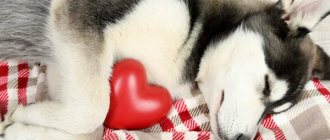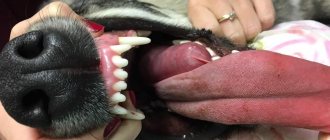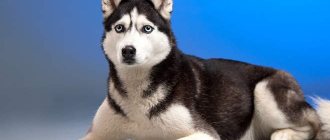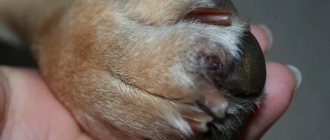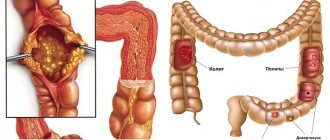Ear diseases are quite painful phenomena that can occur not only among people, but also among our smaller brothers. Moreover, the ears are one of the most unprotected and sensitive organs in dogs, so their diseases can bring a lot of unpleasant sensations to the animal. Every caring owner should know not only about the symptoms of diseases, but also how to provide first aid to their pet at home.
Common Dog Ear Diseases
You can notice the first signs of ear disease by the behavior of your pets: they worry, scratch their ears, walk with their heads tilted to one side, roll on the ground, shake their heads . And in the inner surface of the ear it is easy to detect discharge and foul odors.
Otitis
This disease most often occurs in dogs with long floppy ears: setters, dachshunds, poodles, cockers and others .
There are three types of otitis media:
- Outer. With it, the process of inflammation occurs in the area between the ear canal and the eardrum. This disease is characterized by itching, as a result of which the pet scratches its ears with its paws or rubs them against various objects. Upon visual inspection, discharge with a characteristic odor can be detected in the animal’s ears.
The discharge is present both with an admixture of earwax and pus. Inflammation of the outer ear most often develops due to mites, insects, pathogenic microorganisms or foreign bodies entering the ear canal. The disease can also be triggered by chronic diseases or hypothermia.
As a rule, otitis externa becomes chronic and, despite treatment, recurs again and again, so it is important to pay attention to periodic prevention of the disease.
- Middle ear. Most often it occurs as a result of the penetration of pathogenic microflora through the membrane of the eardrum. The infection comes from the outer ear. Otitis media can cause severe complications that can lead to damage to the facial nerves and infection in the brain.
- Internal otitis. It is characterized by inflammation of the labyrinth of the ear. In this case, the dog begins to lose balance when walking and may fall and stumble.
Internal and otitis media are the most painful and dangerous. Inflammation develops very quickly, the inflamed ear swells. If you do not treat your dog, the pus can affect the meninges, cause meningitis and even lead to the death of the pet.
Allergic otitis media also occurs, which can be caused by an allergy to food or a hormonal imbalance in the dog's body. This type of otitis is characterized by severe itching of the ears and brown discharge.
Inflammation of the ear cartilage
This is a pathological process of an inflammatory nature. It affects the auricle and is accompanied by swelling, swelling and redness of the tissues, and painful sensations. The disease leads to ear deformation or even necrosis of cartilage tissue. Necrosis looks like large ulcers, and the ear cartilage begins to turn black and rot, causing deformation processes.
The cause of the disease can be an ear injury or an infection entering the perichondrium from the internal organs, which are its source. For example, with purulent otitis media. The disease requires serious and qualified treatment, including surgical intervention.
Hematoma
An ear hematoma is a blood cavity between the cartilage and the skin of the auricle. It can be caused by injury, blows, scratches or bites.
With a hematoma, the dog’s ear hangs down and swells, the animal scratches it and thereby injures it more, shakes its head and waves it in different directions.
The disease requires treatment, as there is a risk of infection in the affected area.
Blood from ear
Bleeding from the ear is a dangerous symptom that occurs as a result of injury or a number of diseases.
Most often, blood from a dog’s ear occurs as a result of injury or due to neoplasms: warts, polyps, sebaceous gland adenoma. Invasion of ticks or fleas can also cause bleeding.
Advice! If the bleeding is severe and the dog is shaking its head, then you need to calm it down and try to stop the bleeding. To do this, press a sterile bandage or clean towel to your ear for 4 minutes.
Then you need to moisten a cotton swab with hydrogen peroxide and carefully treat the auricle, carefully examine the ear from the outside and inside. If the cause of bleeding is not external, but internal, then a thorough examination by a veterinarian is necessary.
Sores
Sores usually appear on the tips of the ears. They can degenerate into ulcers, bleed, and emit a foul odor. The owner should not ignore them.
Common causes:
- ear mite;
- vasculitis (inflammation of blood vessels);
- allergic reaction.
Ear mites are a dangerous disease for dogs that can lead to complete deafness. If a puppy's ears are infested with mites, the baby may be developmentally delayed and have difficulty learning commands.
Vasculitis is an inflammation of the blood vessels that results in ulcers and scabs on the ears and redness of large areas of the pet's skin.
Tumors
Ear tumors most often occur in adult dogs who have previously suffered from any head diseases and have not undergone complete therapy.
With this disease, the glands that produce lubricant become severely inflamed. Neoplasms can be either benign or malignant.
To establish a diagnosis, you need to contact a veterinarian who will prescribe effective treatment.
Growths
Growths on a dog's ears are quite common. They are viral in nature and most often are benign. These include warts and papillomas, which slowly grow if left untreated.
Important! Malignant tumors grow quickly and can spread to other tissues; one of the most dangerous types is carcinoma. This disease usually affects older dogs.
Sulfur plugs
Earwax is a collection of wax and sebum in the external auditory canal, which are produced by glands located in the ear.
German Shepherds and Dachshunds are particularly susceptible to this condition because their ear glands produce more wax than other breeds.
Also, if your pet's ears are covered with thick hair, this provokes the formation of wax plugs in the ear canals. Signs of earwax blockage: the dog often shakes its head or partially loses hearing. Earwax practically clogs your dog's ears. Plugs are identified by a veterinarian during a visual examination.
Deafness
Deafness in dogs is a serious condition. As a result, sound vibrations are not converted into nerve impulses.
There are two types of deafness:
- Congenital is an inherited genetic feature that is characteristic of some breeds.
- Acquired - occurs after ear disease (ear mites, otitis, meningitis), injuries, strong sounds.
Congenital deafness cannot be treated, but acquired deafness can be cured by prescribing competent therapy.
Advice! If a dog is deaf or deaf from birth, he may feel especially vulnerable.
It is necessary to look for other ways of communication. Use touch to warn your pet about your departure and arrival, and attract its attention with certain gestures, for example, clapping your hands. Methods of understanding in communication are achieved through training. If you are walking with your four-legged friend in the dark, you can wear a glowing bracelet, vest or other thing that will let the dog know that its owner is nearby.
Main types of ear diseases
Otitis is very common - inflammation of the outer, inner or middle ear. They can be primary, secondary (against the background of another skin or infectious disease), idiopathic (when the causes are unknown). Treatment depends on the classification; if there is an underlying disease, then it must be dealt with along with the symptoms of otitis media. Inflammation of the external auditory canals, like the rest of the ear, can be of the following type:
- Allergic - occurs against the background of allergies to foods, medications, pollen, etc. Discharge from the ear leads to the proliferation of bacteria, which causes discomfort, particularly itching. The dog scratches the affected area and aggravates the symptoms.
- Fungal - fungi always live on the surface of the skin, but with a decrease in immunity or injury, they multiply rapidly. Inflammation, unpleasant odor from the ears and discharge appear.
- Purulent - such otitis media has the most serious consequences, including damage to the eardrum. It is characterized by oily discharge from the ear with an extremely unpleasant odor. Skin ulcers are possible.
In autumn and spring, veterinarians observe the so-called “seasonal” otitis media in dogs, when there is a sharp increase in the production of wax in the animal’s ears. This substance can clog the ear canal, as well as cause inflammation and fungal growth. In some breeds with coarse and hard hair, the ears become overgrown without proper hygiene, dirt and sulfur accumulate in them, and spikelets and thorns remain. This causes irritation, hearing loss, and diaper rash. It is necessary to regularly remove such hair from the ears.
Otodectosis
The culprits of this disease are called Otodectes mites. Every healthy dog has them, but immune failures lead to an increase in their population, and their waste products cause itching, irritation and damage to the skin. Among the negative aspects, one can also note the appearance of a secondary infection against the background of the proliferation of ear mites. Characteristic symptoms for this disease are excessive secretion of wax and then pus, which causes crusts to form in the external auditory canal. The dog loses its appetite, appears weak and depressed in behavior.
Hematomas after injury
As a result of bites, blows, scratching and other mechanical damage to the dog’s ear, a hematoma can occur. It appears very quickly, as hemorrhage occurs on the internal or external part of this organ. It can be noticed by thickening or swelling at the site of injury. Dogs with erect ears (German Shepherds, Siberian Huskies) sometimes have a drooping corner. After a few days, a crunching sensation is felt when pressed at the site of swelling and edema, as air accumulates there. Extensive hematoma and lack of treatment leads to ear decay.
Eczema
Eczema is recognized by skin lesions, local hair loss, redness and itching. It is caused by the accumulation of dust, caustic substances, fleas, water, and natural discharge from the ear. The inflammatory process is accompanied by foul-smelling discharge from the ear canal, and the dog is constantly itching. Sometimes bubbles of liquid form and burst easily when pressed.
Foreign body
If a foreign body gets in, the dog may press and scratch its ears, whine, and shake its head. The most dangerous are small spikelets of grass and thorns that dig into the skin and cause suppuration.
Deafness and hearing loss
A dog may not hear sounds for many reasons, for example, a foreign body, a blockage of wax, or anatomical abnormalities (closed ear canal), but one of the most difficult types of deafness is considered a neurological disease. The consequences vary, as do the treatment options. Some pets are deaf in one or both ears from birth (usually hereditary), others acquire this feature. This can be recognized by the dog’s reaction to sounds, but it is better to leave this to a specialist.
Important! The dog may not hear the sound, but react to the vibrations. For example, clapping your hands, running a car engine, stomping on the floor. In the case of deafness in one ear, self-diagnosis is impossible.
Oncological diseases
Malignant neoplasms in the ear of dogs are recognized by changes in tissue; the skin may be loose and give off an unpleasant odor. There are also various discharges from the ear canal.
Symptoms of ear diseases in dogs
Ear ailments in pets have quite specific and striking symptoms that are difficult to miss.
The main behavioral characteristics of dogs with ear problems are as follows:
- refusal to eat;
- dirty and inflamed ears, swelling;
- dark discharge with an unpleasant odor;
- black sulfur;
- pus;
- squelches in the ear;
- exudate begins to be released (discharge from the ear);
- an unpleasant sickly-sweet or purulent odor emanates from the ears;
- sores, ulcers, growths and bumps on the ears;
- redness and swelling of the ear;
- the pet shakes its head, tilts it to the side, whines when touched, “complains” about pain in the ear, bowing its head;
- partial hearing loss;
- The dog scratches its ears, sometimes scratching them until they bleed.
If you have one of the above symptoms, you must contact a veterinary clinic to receive qualified assistance.
Ear scabies
The disease is caused by microscopic mites belonging to the family Psoroptidae of the species Otodectes cynotis. Ticks of other species are found less frequently. The life cycle of parasites goes through several molts: from egg to larval stages and adult. Characteristics of ticks:
- oval body;
- dimensions 0.3x0.5 mm, males are somewhat smaller;
- adults have 4 pairs of paws, larvae have 3;
- in males all legs end in suckers, in females there are only two anterior pairs;
- feeds on epithelium and lymph.
The disease is widespread in our territory. Infection occurs through direct contact, less often through indirect contact. The largest outbreaks are observed in spring and autumn. Puppies under 6 months of age show the greatest susceptibility to pathology.
Otodectosis persists in populations of stray and wild animals, which are the main sources of spread. In addition to dogs, many species of domestic and wild animals are susceptible to the disease. Domestic dogs are more likely to become infected from cats that have free access to the outside environment.
Clinical picture and diagnosis
The inner surface of the ear is injured when parasites move and feed on the epidermis and tissue fluid. This causes itching in the dog, which causes pets to begin scratching their ears intensively, causing serious injury. This is accompanied by a characteristic clinic:
- constant itching;
- the animal is worried and shakes its head;
- abrasions and scratches are found on the ears.
Severe infestation causes constant anxiety; dogs often stop sleeping, constantly scratch their ears and whine. Gradually, severe scratches and areas of hair loss form, and the skin becomes covered with crusts and ulcers. The skin is damaged on the outer and inner surfaces of the ear and on the head.
Otodectosis is accompanied by weakened hearing; with severe damage to both ears, complete deafness is possible. Exudate is released from the auricle - at the beginning of the disease it is serous, but when the pathology is complicated by bacteria, pus appears. The discharge of pus is not always observed - when the ear canal is blocked by crusts, as well as when the eardrum is perforated, there may be no exudation.
With otodectosis in dogs, brown exudate with a pronounced unpleasant odor accumulates in the ear canal.
The malignant course of the disease is accompanied by inflammation of the middle and inner ear and may be complicated by brain damage. This form is manifested by a sharp deterioration in the condition, the temperature rises 2-3 degrees above normal. A nervous clinic is often noted - seizures, tilting of the head to the painful side.
Confirmation of the clinical diagnosis is carried out using laboratory testing. To do this, take a cotton swab or wrap a swab around tweezers and use it to remove crusts from the inner surface of the ear. The resulting pathological material is examined under a microscope at low magnification. Mites are mobile, so the material should be examined immediately.
Treatment methods for otodectosis
It is necessary to isolate the sick dog. Although these ticks are practically harmless to humans, small children can become infected, and dogs also pose a danger to other animals. In addition, isolation will allow better assistance and ease the course of the nervous clinic. For therapy, special means are used, but the ear canal is first cleaned:
- warm saline is used. solution;
- you can use special commercial preparations that effectively dissolve crusts;
- washing is carried out before each treatment;
- cotton swabs are moistened with an antiseptic and wiped over the ears;
- in case of severe crust formation, it is recommended to pour a small amount of product and massage the base of the ear;
- at the last stage, be sure to dry the sink with cotton wool.
For treatment, acaricidal drugs, antibiotics and anti-inflammatory drugs are used. It is better to introduce them into the ear canals when heated. After application, be sure to massage the base of the ear so that the drug is better absorbed and has an effect on parasites.
The fight against parasites is now usually carried out with the help of effective modern drugs. So, dogs are injected subcutaneously with ivomec or analogues containing ivermectin, aversectin. The advantage of these drugs is that they have a wide spectrum of action, destroying many types of parasitic insects, ticks, and helminths.
If your dog's ears itch, the treatments should be carried out twice. This is necessary due to the developmental characteristics of parasites. Medicines have no effect on mite eggs. Therefore, after some time, a new population of parasites appears, requiring repeated treatment.
Treatment is carried out until the animal recovers completely. With the development of a secondary purulent infection, antibiotics and sulfonamides are required. An ear blockade is effective - novocaine mixed with antibiotics is injected into the base of the ear. Animals may require anti-inflammatory drugs and intravenous fluids.
Causes of diseases
Ear diseases in dogs can vary in nature, depending on the causes of their occurrence. The most common of them are:
- improper care of the dog;
- allergy;
- ear mite;
- primary and secondary infections;
- injuries;
- foreign objects getting into the ear;
- hereditary predisposition, immune diseases;
- hormonal disorders;
- getting cold water into the ear while swimming;
- ear structure (in some breeds);
- oncology.
External sores
If sores appear on the outside of the ears, then the dog has dermatitis. Inflammatory processes in the auricle occur for the following reasons:
- Ear injuries that a dog receives in fights with animals while hunting, during street fights with relatives, or while walking in areas where thorny bushes grow.
- Vasculitis is an inflammatory autoimmune lesion of the capillary walls.
- Atopic dermatitis is an allergic reaction to external irritants.
- Feed allergy, when a hypersensitive reaction to dietary components occurs.
The dog has sores on the tips of his ears from fly bites. Animals with pointed ears that live in kennels suffer. An unbalanced diet combined with dry air leads to cracking of the skin. An ichor is released and flies flock to it. They eat away at the tips of the ears and contaminate them with secondary microflora.
Treatment
Important! Ear diseases in dogs should be treated by a veterinarian.
Before contacting a specialist, you can provide first aid to your pet, and if a person does not have the opportunity to see a doctor, then use therapy methods at home.
Otitis media is treated by cleaning the ear using antibiotics, anti-inflammatory and decongestant drugs.
Inflammation of the ear cartilage requires surgical intervention, so at home the damaged areas are treated several times with antiseptic solutions, such as furatsilin solution.
The hematoma also needs to be treated with antiseptic solutions (iodinol, iodine, boric acid solution); Vishnevsky ointment can be used to speed up tissue healing.
Ear sores are treated with birch tar, iodine, iodine, and hydrogen peroxide.
You can get rid of ear mites by instilling sea buckthorn oil into your ears for 20 days, before carefully cleaning them with a cotton swab dipped in hydrogen peroxide.
Growths in the form of papillomas are treated with celandine juice, iodine, and peroxide solution.
Tumors and any malignant formations in dogs are treated at home with the drug "ASD-2". This remedy strengthens the immunity of a weakened animal. The drug can be purchased at a veterinary pharmacy.
For sulfur plugs, special drops are prescribed that dissolve sulfur. At home, you can gently treat your ears with hydrogen peroxide.
Attention! If you have any ear diseases, you should immediately contact your veterinarian. Treat the dog with medications prescribed by the doctor. Treatment with traditional methods is not always effective and can lead to serious complications.
Ear drops for dogs
There are a number of effective drugs for the treatment and prevention of ear diseases:
- "Amitrazine Forte" - suitable drops for the treatment of demodicosis, otitis media of various types, and mycoses. They are characterized by low toxicity and have good penetrating ability.
- "Aurikan" effectively copes with various ear infections, gets rid of mites, relieves pain and inflammation. Can be used for both treatment and prevention.
- "Bars" is a broad-spectrum anti-inflammatory drug. Accelerates the healing of wounds, cuts, sores, relieves itching and pain.
- "Dekta" - ear drops with propolis. Efficacy against ticks is associated with antibacterial and anesthetic effects; they also eliminate itching and unpleasant odor. Used only for medicinal purposes.
- "Oricin" is a moderately toxic ear drug with a strong analgesic effect. Used to treat all types of otitis.
- "Otibiovin" is a broad-spectrum antibiotic for the treatment of fungal ear infections, eczema, and dermatitis. Contraindicated for use if the eardrum is ruptured.
- “Otovedin” is a low-toxic drug that eliminates not only mites, but also various inflammatory processes.
- "Otoferonol" treats otitis media of bacterial etiology.
- "Otoferonol Gold" effectively eliminates ticks.
- "Otoferonol Premium" is used for the treatment of ear scabies and tick-borne infections. The drug eliminates itching and regenerates damaged skin.
- "Otodepin" is a hygienic ear preparation for the successful treatment of external and internal otitis media, and is also effective in the treatment of ulcers, sores and hematomas. Used for both treatment and prevention.
- "Surolan" - drops for fungal and parasitic otitis media, have antihistamine, anesthetic and anti-inflammatory properties.
Diagnosis and treatment
Most diseases have the same range of symptoms. The task of a veterinary specialist is to conduct a thorough diagnosis and determine the type of pathology that provoked the appearance of characteristic signs of pathology.
It is mandatory to examine the ear using a special instrument - an otoscope. The device is equipped with a special bright backlight and a magnifying glass. Using an otoscope, your veterinarian can look at the type of inflammation.
If you suspect otodectosis, scrape the affected area for further more thorough examination. Discharge from the ear is also taken for analysis to determine the nature of its occurrence.
Microscopic examination makes it possible to identify not only the causative agent of infection in otitis media, but also to determine the sensitivity of the pathogen to a certain type of antibiotic or antifungal drug.
A disease such as ear mites is not determined solely by external examination. In some cases, if the veterinarian suspects inflammation of more than just the outer ear, an x-ray examination is prescribed.
Depending on the degree of neglect of the pathology and the factors that provoked it, adequate therapy is prescribed. Treatment can be carried out at home, but only strictly according to the recommendations and instructions of a specialist.
It is prohibited to replace prescribed medications yourself with similar ones, without prior consultation with your doctor.
Otitis that develops against the background of allergic reactions is eliminated by prescribing local antihistamine ointments, liniments and drops. A mandatory item for allergic otitis media is adherence to a special diet.
If otitis media is caused by pyogenic microflora, a course of antibiotics is prescribed. The doctor individually selects the drug, dosage and treatment regimen. Antibiotics such as Cephalosin and Ceftriaxone are prescribed. Rinse the auricle from accumulated exudate using antiseptics - Chlorhexidine, Miramistin.
Otitis of fungal origin takes longer to treat than bacterial or allergic ones. Special medications are prescribed, and changes in the clinical picture are regularly monitored. If there is no effect from treatment, the doctor adjusts the treatment regimen.
It is advisable to treat a hematoma in the ear by applying a special pressure bandage. The animal must wear the bandage for at least 4-6 days. Next, in the clinic’s inpatient setting, the hematoma is opened, the necrotic tissue structures are treated and removed.
For extensive lesions, the edges of the wound are sutured. After surgery, a special bandage is applied to the entire head of the animal for a period of 10 to 12 days. It may be necessary to add antibacterial ointments - Levomekol, Solcoseryl.
Diagnosed otodectosis is treated using antiparasitic drops - Aurikan, Deternol, Otovedin and Advocate. Before instilling the medicine, it is necessary to clean the external auditory canal using a cotton pad or swab soaked in hygienic lotion.
Next, a few drops of the medicine are dripped into the ear and massaged to ensure proper distribution of the active ingredients over the inner surface of the ear. It is important to note that any drops are intended to destroy adult, sexually mature microscopic mites.
After two weeks, it is necessary to repeat the antiparasitic treatment. Ear mites are a rather insidious pathology. If ear mites are detected in a dog, it is necessary to disinfect the room and replace the bedding. This will prevent re-infection after treatment.
There is no treatment for congenital deafness. The use of special devices, as for humans, is not advisable and will not give positive results. Acquired deafness is treatable. After identifying the exact cause that caused the deafness, the necessary treatment is carried out.
Prevention
In order to prevent many ear diseases in dogs, the following rules must be followed:
- promptly clean your pet’s ears from dirt and wax;
- use prophylactic medications;
- avoid hypothermia;
- Avoid communication between your pet and sick relatives;
- protect your ears from getting large amounts of water into them;
- trim off excess hair in the ear area.
Causes of the disease
Breeds with floppy ears are more susceptible to this problem, since the greenhouse effect occurs, and this is an excellent flora for the development of bacteria. There can be several causes of ear disease in dogs:
- Structural features;
- Poorly ventilated ears in poodles, spaniels, etc.;
- Shepherd dogs, on the contrary, have a wide shell, where a lot of dust gets in;
- Allergy. May appear when changing food;
- Injuries;
- Parasites - bacteria, fungi, mites;
- Hypothermia;
- Water ingress;
- And others.
Which dogs are the most vulnerable?
Absolutely all breeds of dogs are susceptible to ear disease, but in most cases they occur in the following:
- cocker spaniels;
- dachshund;
- setters;
- huskies;
- toy terriers;
- collie;
- Afghan hounds.
Recommendations for owners
It is necessary to prevent ear diseases in your pet. Avoid injury, hypothermia, and when bathing dogs, avoid getting water in the ears. If this happens, dry the ears with a towel.
You should not put anything in your dog's ear without consulting your veterinarian. When treating the ears with cotton swabs, care must be taken not to damage the eardrum.
Statistics say that ear diseases in dogs are among the most dangerous and common ailments, so you should not put off visiting a doctor and let the disease take its course.
Vasculitis
Even the most inattentive owner can find sores, ulcers and scabs on the tips of his dog’s ears. Vasculitis can be noticed immediately, because it is characterized not only by the appearance of sores, but also by hair loss and redness of large areas of the pet’s skin.
Vasculitis is an inflammation of blood vessels, leading to quite serious damage to their walls. This pathology is caused by an autoimmune reaction, during which the protective mechanisms operating in the body begin to actively destroy its own cells, and subsequently tissues.
Causes
This disease is caused by:
- Various types of infections.
- Reaction to medications. Often, owners try to cure their pets on their own, stuffing them with a variety of medications. Quite often, dogs are given vaccines.
- Autoimmune diseases (for example, neoplasia - pathological growth of tissues in the body).
Vasculitis is not a common disease, but it affects young and old animals equally.
Vasculitis in a dog
Signs of the disease
From the moment this pathology appears in the dog’s body, it occurs throughout its entire body. To a greater extent, ulcers may occur at the tips of the ears, at the site of which bleeding appears.
- The affected area begins to swell, although signs of inflammation may not be visible.
- The dog may experience feverish conditions.
- The animal experiences pain, its appetite noticeably decreases and progressive weight loss occurs.
Diagnostics
This disease is not immediately detected. The veterinarian initially checks the animal for the presence of parasites and pathogens of various types of infectious diseases. If no traces of them were found, specialists then move on to a standard diagnostic study, which implies:
- Analysis of urine.
- Taking a complete blood test.
- Blood biochemistry.
In the case of diagnosing vosculitis, it is impossible to do without radiography and ultrasound examination - it is necessary to study the condition of the animal’s internal organs. The more diagnostic methods are used, the faster the main cause of the pathology will be identified.
Therapy
The main decision in the treatment of vosculitis is to determine the root cause that led to the abnormal development of the autoimmune system and its further elimination. Treatment of this disease involves the use of drugs such as:
- Corticosteroids (Pentoxifylline, Prednisolone).
- Antibiotics of the tetracycline series and nicotinic acid (niacin) (Dapsone, Sulfasazalin).
- Immunosuppressants – cyclosporines (Imuran).
Treating a pet requires a combined approach. Some dogs can get rid of vosculitis fairly quickly, while others live with this pathology throughout their lives. Relapses of the disease cannot be ruled out either.
Massage can be considered a non-standard method of therapy.
Disease prevention
The owner should periodically check the blood condition of his pet. It is almost impossible to cure vasculitis at home on your own.


